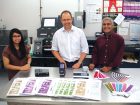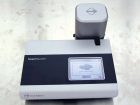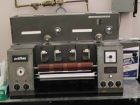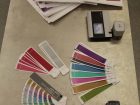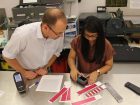
Features
Opinion
Tech
Best of PA 2015: A New Era in Colour Measurement
January 5, 2016 By Martin Habekost and Abhay Sharma
With the introduction of the M measurement modes, the past couple of years have brought a range of incredible new measurement devices that can change the way any commercial printer approaches their pressroom (originally publshed in PrintAction’s October 2015 issue).
(EDITOR’S NOTE: This is a relatively long, highly important technical article produced from original research by Ryerson University’s Dr. Martin Habekost and Dr. Abhay Sharma, with contributions from fourth-year student Alyssa Andino. If preferred, a PDF version of the article is available for printing in PrintAction‘s archives.)
There are some exciting new developments in the world of measuring instruments that tackle the perennial issues of measuring wet and dry press sheets, measurement of papers with optical brighteners, doing a press check with metallic inks or trying to match a press sheet to a proof – new standards and new instruments are now available that eradicate many of these practical colour issues. The Barbieri SpectroPad2, the Techkon SpectroDens and the X-Rite eXact have been tested and evaluated in Ryerson University’s pressroom in different applications from inkjet photo papers to metallic PANTONE inks on press.
Spectrophotometers are routinely used for colour measurement and colour management in many commercial printing and proofing workflows. In the case of media containing optical brightening agents, UV-induced fluorescence has lead to poor levels of agreement between models from different manufacturers, or different models from the same manufacturer. If instruments produce different readings, then problems with colour matching can occur when colour management is done in prepress with one instrument, but a different instrument is used to do spot checks at press-side.
A major contributor to inter-model differences is the amount of ultraviolet (UV) energy in the instrument. When a paper contains brightening agents, instruments have reported different measurements for the same sample. The new standard ISO 13655 now clearly defines four measurement modes: M0, M1, M2 and M3. In broad terms, M0 is a legacy mode for all devices prior to the implementation of the new measurement modes, while M1 and M2 are UV-included and UV-excluded modes, respectively. The M3 mode is a polarizing mode for use in ink dry-back on press or for measuring metallic inks and other special effect inks.
New ISO 13655 measurement
The problem to date has been that there was no clear specification for handheld spectrophotometers for prepress and pressroom use. The new ISO 13655 standard provides much more clarity for the instrument measuring conditions, which has brought instruments from different suppliers into closer agreement. The instruments evaluated here are new instruments that meet this standard. We provide an explanation for ISO 13655 and its implementation for the general user.
The legacy mode M0 represents the majority of measuring instruments used in the field today. The X-Rite 530, i1Pro and iSis are all M0 instruments. M0 is directed to instruments that use a tungsten lamp to illuminate the specimen being measured. The tungsten bulb based device used to be the primary type of device on the market. It should be noted that the UV component can be very weak in these instruments as they have very low energy in the 300-400 nm range.
An M0 instrument can safely be used for process control applications where it is adequate to make repeatable measurements, it can be used in situations where it is not necessary to know the “absolute” measurement value and there is no exchange of information or correlation with other measurement scenarios. In general, the M0 mode exists as a catch-all mode so that we have within the new ISO standard a category for legacy devices. The M0 mode enables older devices to have a place within the new standard.
M1 is known as the “D50 mode” or “UV included mode” – devices can use two different methods to achieve this mode. The light source in the instrument must create the effect of CIE Illuminant, D50. A major difference (and improvement) over earlier specifications is that in this mode the spectral power distribution of the illuminant should approximate D50, thus the relative amount of UV and visible wavelengths is now clearly and unambiguously specified.
The clarification for spectral power distribution in measuring instruments, ISO 13655, is accompanied by a similar clarification in the standard for viewing booths ISO 3664. Via updated standard ISO 3664, emphasis has turned to requiring a closer simulation of Illuminant D50 thus clarifying the amount of UV illumination in the viewing booth. In the current context, ISO 3664 has called for tighter tolerances on the quality of the light source to ensure that it closely matches the D50 (M1) curve especially in the UV part of the spectrum.
We may say that M1 is, in fact, nothing more than an ISO 3664 source in the instrument. By implementation of these two ISO standards, we arrive for the first time at a situation where instrument reported values are in agreement with what is observed visually in a viewing booth. D50, one of the standard viewing booth modes, is the basis for the Profile Connection Space in the ICC architecture. M1 mode within instruments corresponds to ISO 3664 for viewing booths, all of which make M1 the most desirable mode for today’s colour measurement and colour management systems. Instruments that offer M1 mode are devices such as X-Rite’s i1Pro2 and iSis2 – note the “2” in the model name, indicating they are second generation instruments for the new ISO standard.
M2, defined as a “UV-cut” mode, removes all UV light from the measurement system, below 400 nm. ISO 13655 states, “The spectral power distribution of the measurement source… shall only contain substantial radiation power in the wavelength range above 400 nm…” M2 is thus a UV-cut mode, filtering out any UV component below 400 nm, in the instrument’s light source. How is this mode used in practice? There will be times when a customer will request a print to be measured using M2 because the lighting used to display the job is expected to be free of UV content. A museum is an example of one such place that may use UV-free lighting. In colour management circles there may be instances that require removing UV light from the measurement system. With the new standard there is a specific definition for “UV-cut” and the wavelength at which it occurs.
M3 is a polarizing mode (for measurement of wet offset press sheets) and consists of UV-cut, up until 400 nm and then a polarizing filter is applied to the remaining wavelengths. The main use of M3 is to limit or completely remove surface reflections. In the offset printing sector, the customer pays for the final dry product. One of the main concerns is that the press sheets come off the press wet and as they dry the density of the ink drops. The M3 mode can aid printers in cutting the surface gloss from wet inks, and if drying is primarily represented by a change in surface gloss, then by removing the gloss, we may have a better prediction of the final expected dry density. It is generally agreed that a polarization filter can give less difference in density readings between a wet and a dried-back press sheet, so the use of a polarizing filter can provide a better predictor of dry density from wet density readings.
There is considerable debate around the use of polarization filters for density measurements and for use in metallic inks. The use of polarization filters is somewhat controversial since the effect is not controllable and each situation will produce different results, until now there have been no published standards for the use of polarization filters. The situation was akin to the use of UV light in the instrument, it was not stipulated or clearly defined. ISO 13655 now clarifies the situation for the response of the polarizing filter. The M3 mode is examined in the present study for use in measurement of metallic inks – an area that has been a thorny issue for measurement and control of metallic inks on press. Practical testing using the Techkon SpectroDens and X-Rite eXact show that the M3 mode provides huge improvements when controlling metallic inks on press.
Barbieri SpectroPad2
New in the market today, from different companies, are instruments that meet the ISO 13655 standard. The Barbieri SpectroPad2 spectrophotometer was evaluated at Ryerson GCM for use in photo papers containing high amounts of optical brighteners. The SpectroPad2 has a novel upright design with a large, clear panel. To measure, the head moves along for a small distance until a small beep reports the measurement in the touch-screen LCD panel. The device connects directly to a laptop or other computer via Barbieri Gateway software using USB or WiFi, or at press-side the LCD panel can be set to immediately report a pass or fail colour test.
Importantly, the SpectroPad2 is compliant with the M0, M1 and M2 measurement modes – it is highly recommended that a press shop should only buy a device that complies with these standards. The white calibration tile is neatly hidden and is unlocked when white calibration is done by the user. The device is clean, simple, elegant and a charm to use, and has applications in offset printing as well as all digital applications such as large-format inkjet. Barbieri is an Italian company, run by brothers Stefan and Markus Barbieri, supplying a range of spectrophotometers with a wide European user base, and support here in Toronto.
Techkon SpectroDens
The Techkon SpectroDens is a sophisticated German instrument in which we focused on the use of the M3 measurement mode. The SpectroDens also has a neatly hidden calibration tile in the charging base for the instrument. The SpectroDens can also be used to see if a press sheet is in compliance with the G7 process. The latest model even offers a hand-scanning mode for the measurement of the G7 target.
In the current evaluation we focused on the M3 mode, which can be used for measuring metallic inks and other special effect inks. The M3 measurement mode describes the use of two polarizing filters before the reflected light from the sample hits the sensor.
In the test, we measured wet and dry metallic inks to see how well the new M3 measurement mode works when it comes to measuring such inks. Ten metallic inks with PANTONE P877 silver or P874 gold as base metallic ink were printed on a Prüfbau printability tester and measured. The reference point was the printed metallic ink in the PANTONE metallic book. A range of samples with declining ink amounts were printed. The Techkon SpectroDens was used to measure L*a*b* values and the density of the samples.
The colour data and the density were recorded using the SpectroDrive software from Techkon, which can be downloaded for free. The software can connect to the instrument over WiFi, if both devices are on the same wireless network. The other option is to connect the instrument with the supplied USB cable to a USB port of your computer. With help of the software a colour standard can be set and then measurements can be taken of the samples and compared to the standard. The colour difference between standard and sample can be calculated in various colour differencing equations. For the evaluation of the M3 measurement mode, we used the DE2000 equation because the calculated DE2000 values correspond quite well with how we, as human observers, perceive colour differences.
Since the SpectroDens, and all other modern spectrophotometers measure the light spectrum that is reflected back from the sample, they do not calculate density in the same way as traditional filter-based densitometers. In spectral-based densitometers, the reflected light spectrum is used from which to calculate density. This is the reason why the measuring device is capable of giving L*a*b* values and printed ink density at the same time.
Press run with silver and gold metallic inks
After printing 10 different metallic inks on the Prüfbau printability tester, six colours were chosen for a pressrun on our 2-colour Heidelberg Quickmaster QM46. Again, we used the printed ink density from the PANTONE metallic book as a yardstick. After a proper set up and achieving the target ink density, we turned the ink ductor off and ran 200 consecutive prints. For the analysis, a press sheet was measured every 10 sheets and the results collected with the SpectroDrive software and recorded in Excel. The results from the prints on the Prüfbau printability tester and the QM46 press run aligned quite well in regards to which metric can be used for controlling metallic inks on press.
For the metallic ink project we also used an X-Rite eXact which has been switched into M3 measurement mode. The same samples (Prüfbau and QM46) that were measured with the SpectroDens were also measured with the eXact. X-Rite offers the DataCatcher software which can connect via Bluetooth or USB-cable with instrument. The data can also be stored directly into an Excel spreadsheet.
Very important and relevant findings show that the M3 mode can be used to measure spectral density and the density relates well to ink film thickness of metallic ink. When we increase or decrease the amount of metallic ink, the density reading increases or decreases accordingly, thus we have an instrument and metric to control metallic ink on press. The other critical result here is that two different instruments – the Techkon SpectroDens and the X-Rite eXact agree in their measurements of the same sample. A main result from this project is that there is close agreement in terms of density between the Techkon SpectroDens and the X-Rite eXact for the metallic colours. The density function on both measurement devices allows to easily track the printed ink density on press. Differences start to show up when thick ink films are being printed, when one tries to print a real intense or dense colour. At this point, the measurement values start to drift, but you have to keep in mind that at a heavy ink film and high ink densities very little light reaches the light sensor and, therefore, the calculated L*a*b* values and ink densities can start to be slightly different.
Another option would be to track the L*-value of the printed ink. L* is a lightness measurement. So, if the L* value is below the target L*-value than the ink is too dark and too much ink is applied on press. If the L* value is above the target value then the ink is too light and a little bit more ink has to be printed.
Our results clearly show that the recorded density values decrease as the printed ink film thickness decrease. A decreasing ink film thickness means that the print gets lighter, which in return, in shown in the increasing L*-values. A higher L*-value means, that the colour is less intense than the desired colour and a thicker ink film has to be printed on press by either opening the ink keys more, or by increasing the ink dwell in the ink fountain.
More than hype
In many print shops there are different devices used in prepress and press, or a printer may have a Toronto and Ottawa location with an instrument in each facility. The new ISO 13655 standard brings all these different instruments into close alignment. Further, the ISO 13655 enables different measurement modes for UV-included and UV-excluded measurements and also the M3 mode for measurement of metallic inks. Together these changes provide huge advantages to practical colour measurement and colour matching at press-side.
It is not marketing hype, press shops should genuinely seek to upgrade their instrumentation and in this work we evaluated the Barbieri SpectroPad2, Techkon SpectroDens and X-Rite eXact – these all meet the new ISO standards and are all easy to use, software-driven devices. Specifically in this testing, the Techkon SpectroDens and the X-Rite eXact can both be used to measure metallic inks on press, using the M3 measurement mode. A relatively easy to understand metric for on press control is the printed ink density that both instruments can show in their LCD displays. Using the printed ink density allows press operators to measure and control metallic inks like they are controlling four process colours!
Print this page
